
Home
Pilot
Escape
303 Squadron 1
303 Squadron 2
A New Home
and Finally
Links
Contents
| |
303 Squadron...
| The final phases of the
Battle of Britain were coming to a conclusion. By the end of September, it
was clear that the RAF had air superiority and the German plans for
invasion, "Operation Sea Lion", were cancelled. 303 Squadron had
flown 35 combat missions. Mirek had joined most of then and flown 42 sorties from the end of August through to the beginning of
October, more than any other pilot.
The squadron was rotated out to
Leconfield on the 11th October for rest and recuperation. Despite having
joined the battle late, 303 ended the Battle of Britain with 126
victories, the highest of any RAF squadron.
|
The squadron
returned to Northolt in January 1941. By now, flights were offensive
rather than defensive; the Luftwaffe had effectively given up day time operations over
England. On his own admission, Mirek found these low level sweeps
"fun". Attacking enemy airfields and other "targets of
opportunity", pilots ranged over France and the Low Countries causing
havoc wherever they went. "Rhubarbs", as these sweeps were
known, were complemented by joint fighter and bomber sweeps known as
"Circuses".
|
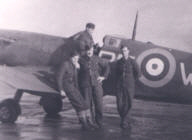
Mirek's
Spitfire Vb RF-W with groundcrew, Northolt 1941
|
|
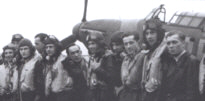
Mirek,
second from left, with other pilots of 303 Squadron at Leaconsfield |
303
Squadron re-equipped with Spitfires in January 1941. Mirek, like most pilots, loved the Spitfire.
By February the sweeps over occupied France were intensifying. On 25th
February, a dozen Spitfire from 303 Squadron joined the Blenheim bombers
over Canterbury, to attack targets in northern France. |
| The squadron headed towards
Calais, encountering strong anti aircraft fire on the way. Unable to find
enemy aircraft willing to engage, they headed back to England, crossing
the coast until further intensive AA fire. Mirek felt his Spitfire shudder
and saw an Me 109 behind him. He also saw the ragged remains of his tail
plane. Diving into clouds, he escaped his pursuer, eventually landing back
at Northolt with "a completely smashed rudder, both mainwheel tyres
shot through, five holes in the port wing and one hole in the
fuselage". |
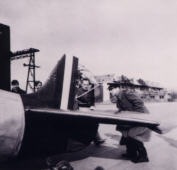
Tail
of Mirek's Spitfire N3108 RF-P, minus rudder |
| It was on another routine bomber escort over France on 23rd June 1941 that Mirek
encountered an ME109F attacking two Spitfires from above and
behind. He shouted a warning over the
R/T, and according to his Combat
Report, the Spitfires turned away. The ME followed and Mirek turned in
after it. He fired bursts from cannon and machine guns from 400 yards,
closing to 100 yards before the enemy aircraft exploded. |
|
Attacks on continental
Europe continued, with large scale roving fighter sweeps called
"Rodeos" and fighter escorted bomber attacks on specific
targets. Although these operations were enjoyable, they were not without
risk. Later battle assessment showed that pilot losses did not outweigh
real damage caused. Indeed, although Mirek was busy trying "to
destroy a train just as it goes into the tunnel", he learnt at some
cost that you can never be too alert. |
|
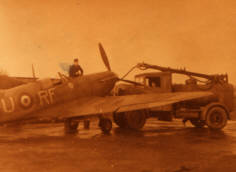
Mirek's
Mk VB Spitfire RF-U W-3506 , 1941 at Northholt |
On 2nd July 1941 during a routine
"Circus" over Lille, he "forgot to check his mirror".
He never saw the new Me109F's that "bounced" him. Machine gun bullets
and cannon shells ripped through his aircraft. One cannon shell came
through the armour behind his cockpit seat, through his shoulder
blade and on into the instrument panel. It exploded behind the panel, throwing
glass and metal back into his face. |
| Surprised, shocked and
"very angry" with himself, he managed to escape his pursuer and
nurse his badly damaged Spitfire back over the channel, landing it without
further incident at Martlesham. According to the squadron Combat Diary
"he climbed from a cockpit which was dripping with blood; he
collapsed walking to Sick Quarters". |
| He was taken immediately to
East Suffolk Hospital in Ipswich where emergency surgery saved him life
and his arm. He spent the next five months recuperating from his wounds,
undergoing two further operations to graft skin over the large hole in his
shoulder. He returned to active duty with 303 Squadron in December 1941,
flying with them until the end of 1942. |
|
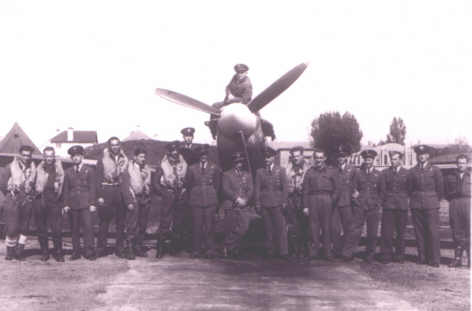
303
Squadron, Northolt 1942 (left
to right) Sgt Stasik, P/O Socha, P/O Kolecki, F/O Lipinski,, F/O
Horbaczeski, F/O Schmidt, F/Sgt Giermer, F/Lt
Jan Zumbak, S/Ldr Kolaczowski, F/O Jan Glowacki, F/Lt Walerian Zak, F/Sgt
Popek, F/O Bienkowski, F/O
Klosin, F/O Kolubinski, F/Sgt Karcmarz, F/Sgt Sochacki and F/Sgt Miroslaw
Wojciechowski |
On
the 7th November 1942, he was awarded the Virtuti Militari by General
Sikorski.
Just
days later, he transferred from 303 Squadron to No 2 Flight Instruction
School in Montrose.
|
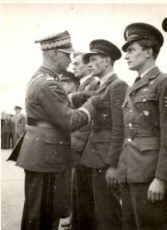
Miroslaw
Wojciechowski about to receive his Virtuti Militari from General Sikorski,
1942
|
|
From
1943 until 1945, Mirek shuttled between 303 Squadron and various Flight
Training Schools - teaching young men to fly and fight. He later said that
"this was more dangerous than dog fighting" and those who train
fighter pilots might well agree with him. |
| Meanwhile, back home in
Poland, conditions were going from bad to worse. Mirek's uncles, after their capture by the Red Army,
were never seen again and were almost certainly amongst those that
perished in the massacre at Katyn.
Although his mother, his
sister Marisia and his sister Janka's children were safe in the south, in Warsaw life
was increasing dangerous.
|
|
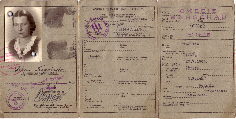
Janka's
fake ID - "Irina" |
Janka's work with the
resistance, principally as a courier in and out of Warsaw, was high
profile, carrying with it the very real risk of arrest, torture and
execution. This was aside from the general hazards of living under
the occupation of the General Government, |
| Indeed, in late 1944, Janka was picked up in a
German street sweep in Warsaw and sent to Ravensbruk concentration camp.
Fortunately, her real identity and her job with the resistance was not
suspected. Her
language skills led her, initially, to be used as a camp interpreter.
Later, she was sent to the medical experimentation wing, where she was
subjected to multiple "vaccination" tests, which permanently
disabled her. In January / February 1945, her condition was so poor that
she was one of hundreds of desperately ill inmates "traded" to
the Red Cross by the German authorities, in the hope of some leniency of
their treatment after war's end. Janka was evacuated with many others also
too sick to last: in a final, brutal irony, the Germans later forced
thousands of the remaining "healthier" camp inmates on a death
march into central Germany. Most fell by the wayside, too exhausted to
move and were either shot by the retreating Germans or left to freeze to
death in the biting wintry cold.
At war's end, Mirek's remaining family,
including Janka'a children found their way back to Torun.
|
|
